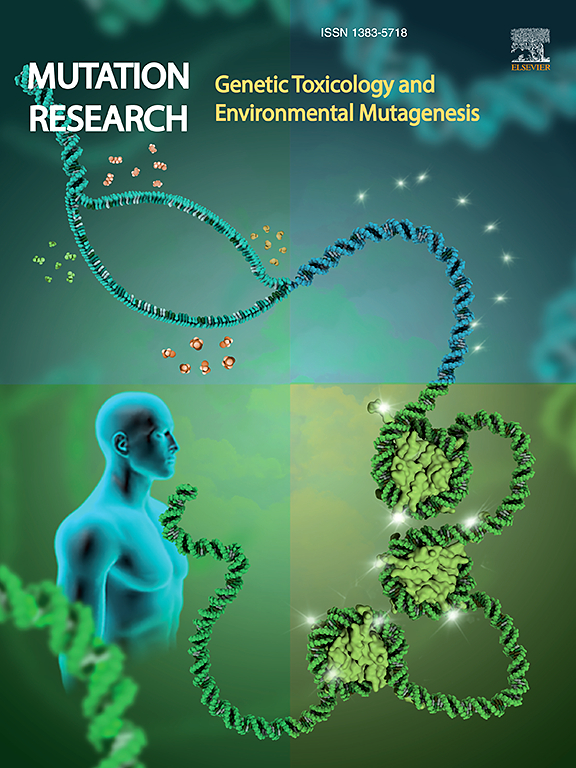xthA缺失对γ射线、UV-C光和其他基因毒性物质激活大肠杆菌SOS反应的影响
IF 2.5
4区 医学
Q3 BIOTECHNOLOGY & APPLIED MICROBIOLOGY
Mutation research. Genetic toxicology and environmental mutagenesis
Pub Date : 2025-08-01
DOI:10.1016/j.mrgentox.2025.503879
引用次数: 0
摘要
SOS反应包含一组约45个基因,这些基因与DNA损伤的修复或耐受有关。这些基因通常是被阻断的,但当遗传物质发生病变时,就会产生SOS信号,允许它们表达。大多数类型的DNA损伤必须经过修饰或处理才能诱发SOS。在之前的工作中,提出了一个模型,提出了从不同类型的病变到诱导反应的可能路径。其中一个可能的途径是通过碱基切除修复机制(BER)。由于在大肠杆菌中,AP核酸内切酶外切酶III在这一修复途径中起着关键作用,因此在本研究中,我们评估了xthA产物在伽马射线、UV-C光、甲磺酸乙酯、甲磺酸甲酯、丝裂霉素C、过氧化氢和过氧化叔丁基氢引起的DNA损伤的处理中参与SOS反应。将一株xthA缺陷菌株和一株wt菌株暴露于不同的基因毒性物质中,分析其存活和SOS诱导情况。结果表明,wt菌株和xthA突变体的存活率和对各基因毒性物质的SOS诱导存在差异;根据DNA损伤类型的不同,与wt菌株相比,SOS反应水平或高或低。这表明,虽然外切酶III酶的AP内切酶作用在大体积和甲基化病变发生时抑制SOS诱导,但当ROS产生损伤时,它会增强SOS诱导,这与先前提出的模型一致。本文章由计算机程序翻译,如有差异,请以英文原文为准。
Effect of xthA deletion in the activation of the E. coli SOS response by gamma rays, UV-C light and other genotoxic agents
The SOS response contains a set of about 45 genes related to the repair or tolerance to DNA damage. These genes are normally blocked but when lesions upon the genetic material occur an SOS signal is generated allowing their expression. Most types of DNA lesions must be modified or processed to induce SOS. In a previous work, a model was proposed suggesting the possible paths that could be followed from the different types of lesions to the induction of the response. One of these possible routes is through the base excision repair mechanism (BER). Since in E. coli the AP endonuclease exonuclease III plays a key role in this repair pathway, in the present study we evaluate the participation of xthA product in the processing of DNA lesions made by gamma rays, UV-C light, ethyl methanesulphonate, methyl methanesulphonate, mitomycin C, hydrogen peroxide and tert-buthylhydroperoxide to trigger the SOS response. A strain defective in xthA and a wt strain were exposed to different genotoxic agents and survival and SOS induction were analyzed. The results show differences in the survival and SOS induction to each genotoxic agent between the wt strain and the xthA mutant; depending on the type of DNA damage inflicted, the SOS response level was either higher or lower compared to the wt strain. This suggests that while the AP endonuclease role of exonuclease III enzyme suppresses SOS induction when bulky and methylated lesions occur, it enhances SOS induction when the damage is generated by ROS, in agreement with a previously proposed model.
求助全文
通过发布文献求助,成功后即可免费获取论文全文。
去求助
来源期刊
CiteScore
3.80
自引率
5.30%
发文量
84
审稿时长
105 days
期刊介绍:
Mutation Research - Genetic Toxicology and Environmental Mutagenesis (MRGTEM) publishes papers advancing knowledge in the field of genetic toxicology. Papers are welcomed in the following areas:
New developments in genotoxicity testing of chemical agents (e.g. improvements in methodology of assay systems and interpretation of results).
Alternatives to and refinement of the use of animals in genotoxicity testing.
Nano-genotoxicology, the study of genotoxicity hazards and risks related to novel man-made nanomaterials.
Studies of epigenetic changes in relation to genotoxic effects.
The use of structure-activity relationships in predicting genotoxic effects.
The isolation and chemical characterization of novel environmental mutagens.
The measurement of genotoxic effects in human populations, when accompanied by quantitative measurements of environmental or occupational exposures.
The application of novel technologies for assessing the hazard and risks associated with genotoxic substances (e.g. OMICS or other high-throughput approaches to genotoxicity testing).
MRGTEM is now accepting submissions for a new section of the journal: Current Topics in Genotoxicity Testing, that will be dedicated to the discussion of current issues relating to design, interpretation and strategic use of genotoxicity tests. This section is envisaged to include discussions relating to the development of new international testing guidelines, but also to wider topics in the field. The evaluation of contrasting or opposing viewpoints is welcomed as long as the presentation is in accordance with the journal''s aims, scope, and policies.

 求助内容:
求助内容: 应助结果提醒方式:
应助结果提醒方式:


